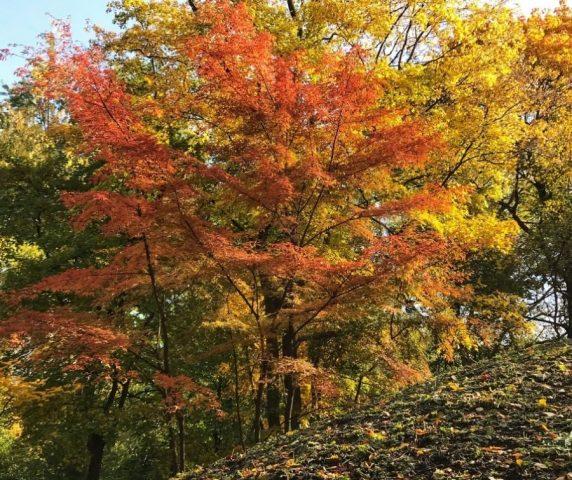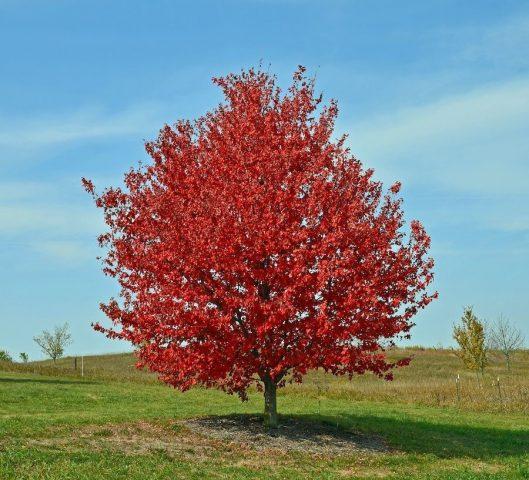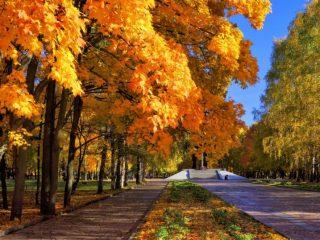Content
- 1 Description and characteristics of maple
- 2 Varieties of maple with names and photos
- 3 Maple varieties for the Moscow region
- 4 Conclusion
Types of maple are very diverse and number in the dozens. Before planting a tree in your summer cottage, you need to familiarize yourself with the popular varieties.
Description and characteristics of maple
Maple (Acer) is a plant of the Sapindaceae family. It is a tree up to 10-40 m tall or a medium-sized shrub. It has palmate, complex pinnate or trifoliate leaves with large veins; the plates are located on the shoots opposite on the petioles. Flowering occurs in late winter or early spring. Some species bloom even before the leaves appear. The buds are five-petaled, green, orange or red, very small in size, collected in umbrellas, shields or brushes.
The description of the common maple states that 2-6 weeks after flowering it forms so-called bipods, consisting of identical halves. The fruits containing the seed rotate as they fall from the branches and are carried through the air over long distances.
Different types of culture are found in Asia, North America and Europe. The tree prefers temperate latitudes; it is rarely seen in the tropics. The culture is found in the northernmost regions of Africa and does not grow at all in Australia and South America.
Varieties of maple with names and photos
Maples are very different - more than 160 species are known, about 20 of them can be found in Russia. Several plants deserve special attention.
Holly (sycamore)
Norway maple (Acer platanoides) is one of the most common species, found in Europe, central Russia and South-West Asia. It grows up to 28 m above the ground, has a dense spherical crown and strong branches directed upward. In young plants, the bark is greyish-brown, smooth, in old plants it is almost black, covered with long narrow longitudinal cracks.
In the first half of May, the tree bears fragrant yellow-green buds, collected in clusters of up to 30 pieces. Flowering continues until the leaves bloom. The plates are palm-shaped, lobed, dark green in summer and yellow or orange in autumn.

Norway maple lives in nature for about 150 years
Ashleaf maple (American)
The appearance of ash maple (Acer negundo) is quite simple - the tree does not have high decorative characteristics. Found everywhere in Eurasia and North America. It is highly frost-resistant and winters without problems in Siberia and the Urals. The leaves are complex-pinnate, the crown is shapeless and loose.
In gardening, wood is used to create hedges and green areas. The species quickly recovers after pruning and produces a large number of side shoots.

The ash-leaved species actively reproduces by self-sowing and often becomes a weed in cities
White
False platan or white maple (Acer pseudoplatanus) in natural conditions reaches 35 m in height. The crown of the tree is wide, dome-shaped, the leaves are palmate-lobed, dark green, purple or golden in color. In spring, the species blooms with yellowish buds, collected in long brushes of 20-50 pieces. Young trees are covered with smooth gray bark; with age, it becomes coarser and begins to flake, and the inner pinkish and pale brown layers become noticeable.
The species is distributed in Central Europe and South-West Asia, as well as in Spain, Turkey and the Caucasus. It is thermophilic and shade-tolerant, prefers moist brown soils with a high lime content.

The lifespan of white maple is about 400 years
Tatar
Tatarian maple (Acer tataricum) is a small tree with thin branches, reaching 12 m in height. The bark of the plant is gray-brown, thin, with dark grooves, which turn into cracks with age. The branches of the decorative maple species are red-brown, angular, with simple whole or lobed leaves with serrated edges. The flowers are greenish-white, with a slight red tint, collected in thick fragrant panicles. They appear in the spring immediately after the blades bloom.
The tree becomes especially decorative in the fall, when its leaves acquire a bright purple color. The species is distributed in Europe, South-West Asia and Eastern Siberia. It grows mainly along ravines, in deciduous forests and on river banks.

Tatarian maple tolerates frost, drought and unfavorable environmental conditions well
Field
Field maple (Acer campestre) is characterized by increased endurance and is often used for landscaping in megacities. It reaches 15 m in height and has a wide conical crown. In the photo of a maple tree with leaves and flowers, it is noticeable that its plates are pale green in summer and yellow in autumn, the bark is brown, covered with light longitudinal lines. The flowers of the plant are very small, almost indistinguishable.

Field maple blooms in late April or May for two weeks after the leaves bloom
The variety is found in the Crimea, the Caucasus and the central part of Russia, and is shade-tolerant. In the first few decades it develops very quickly and does not suffer from drought. Grows best in fertile soils and can withstand slight salinity.
Manchurian
Manchurian maple (Acer mandshuricum) is a beautiful tree up to 20 m tall with trifoliate leaf blades and rather large flowers. Blooms in May, seeds ripen in September. The tree has a beautiful openwork crown, which turns a bright orange-red color with the onset of autumn.
The variety is common in China and Korea, as well as in the Primorsky Territory. Grows in deciduous forests and on mountain slopes, prefers open areas and well-drained soils.

The Manchurian maple species develops faster in adulthood than in youth
Greenbark
The maple species exists in the southern regions of the Far East and is also found on the Korean Peninsula and in China. It is a plant up to 15 m tall, distinguished by green bark with longitudinal stripes. The crown of the species is spherical.
The greenbark maple (Acer tegmentosum) has three-lobed leaves that turn golden yellow in the fall.In spring it blooms with graceful small buds collected in loose inflorescences. It is characterized by winter hardiness and rapid growth.

Greenbark maple is found in mixed forest plantations and dense coniferous forests
Red
Red maple (Acer rubrum) is widespread in North America and Canada. It reaches 28 m in height, the trunk diameter is about 1.6 m. The leaves of the species are simple, palm-shaped with 3-5 lobes, pale yellow. In autumn they acquire a beautiful bright red color.
According to the botanical description of the maple, the species blooms in early spring even before the leaves appear. The buds are divided into two types - red female buds, collected in brushes, and yellow male buds, barely noticeable on the branches.

Red maple lives for 100-200 years
Prirechny (Ginnala)
River maple (Acer ginnala) grows only 6 m above the ground. The species is often formed as a tall shrub. The leaves of the plant are three-lobed, slightly elongated, the buds are collected in fragrant panicles. In autumn, the tree bears bright red fruits and becomes especially decorative.
In its natural environment, the species is found in East Asia, Siberia and the Far East. It grows along the banks of reservoirs and in damp meadows, on sandy and rocky soils. It prefers well-lit places and develops especially quickly in the first years of life.

Riverside maple can withstand frosts below -40 °C
Japanese maple
The heat-loving Japanese maple (Acer japonicum) is a low tree when developed in natural conditions or a shrub up to 10 m above the ground when cultivated. It has gray smooth bark without cracks and reddish branches, rounded serrated leaves with 7-11 lobes. In autumn the plates turn orange-red with yellow speckles.
The Japanese species blooms with beautiful crimson-purple buds in drooping corymbs. Flowering begins even before the leaves appear in April.

Japanese maple in Russia is an endangered species listed in the Red Book
In its natural form, the tree grows in northern Japan in mountain forests. You can also see culture in Russia in the Sakhalin region.
Other popular types
In addition to the main ones, there are other types of maples in Russia that are in demand among summer residents. Several of them deserve special mention.
Curly (Acer circinatum)
The species grows in North America in deciduous forests and forest edges, sometimes appearing on fire sites. It is a multi-stemmed shrub or small tree up to 8-12 m tall. A low-growing variety of maple often forms dense thickets; in open areas it has a straight trunk, and in the shade it can bend to the ground. The branches are thin, covered with smooth greenish or reddish bark.

Curly maple blooms in April and May
Black (Acer nigrum)
The species reaches 40 m above ground level and is found naturally in eastern North America. It is characterized by rapid development, has very dark, almost black leaves on red petioles. In nature, it settles in mixed forest plantations and on the banks of reservoirs.

The crown of the black maple reaches 8 m in diameter
Three-lobed (Acer monspessulanum)
The species grows in the Mediterranean, is a deciduous tree up to 10 m in height. The plates are shiny dark green, small, with three lobes. In autumn they become golden or bright red in color. The flowers appear in the spring immediately after the leaves bloom and are whitish or yellow-green.

The three-lobed maple usually sheds its leaves no earlier than November.
David's maple (Acer davidii)
The species can be distinguished by its smooth bark with a striped green and white pattern. The tree grows mainly in China and is found quite high in the mountains. It has a spreading crown, rising up to 15 m above the ground. The leaves of the tree are dark green, up to 10 cm in length, ovoid or heart-shaped in shape.

David's maple grows well in acidic or neutral soils
Maple varieties for the Moscow region
Most species are suitable for cultivation in the Moscow region. But several decorative varieties are especially popular among summer residents.
Crimson Sentry
This beautiful maple variety has a pyramidal crown of a rich burgundy color. Reaches 8 m in height, prefers to grow in bright sun or light partial shade. The variety is often used as a contrasting element in the landscape or for planting in alleys.

Crimson Sentry is highly frost-resistant and tolerates winter well in the Moscow region
Royal Red
The tall variety rises up to 15 m above the ground, the crown spreads up to 10 m. You can recognize the variety by its bright red leaves, which become dark purple by mid-summer and lighten slightly in the fall. The crown is pyramidal, dense.

Royal Red gains up to 40 cm in height per year
Carnival
The dwarf maple variety grows only up to 3 m. It has green leaves with a cream edging, and from a distance it appears almost white. Looks impressive when grown in the garden, prefers sunny areas.

Variety Carnival grows well on dry calcareous soils
Flamingo
Another low-growing variety has white-green leaves; young plates have a pinkish tint. Characterized by rapid growth up to 50 cm per year. It tolerates winter frosts well in the Moscow region and does not require careful shelter.

The Flamingo variety grows up to 5 m
Conclusion
There are dozens of types of maple; there are frost-resistant and heat-loving, tall and dwarf varieties. Before planting, you need to get acquainted with the characteristics of the plant and understand whether it can develop in a particular region.








